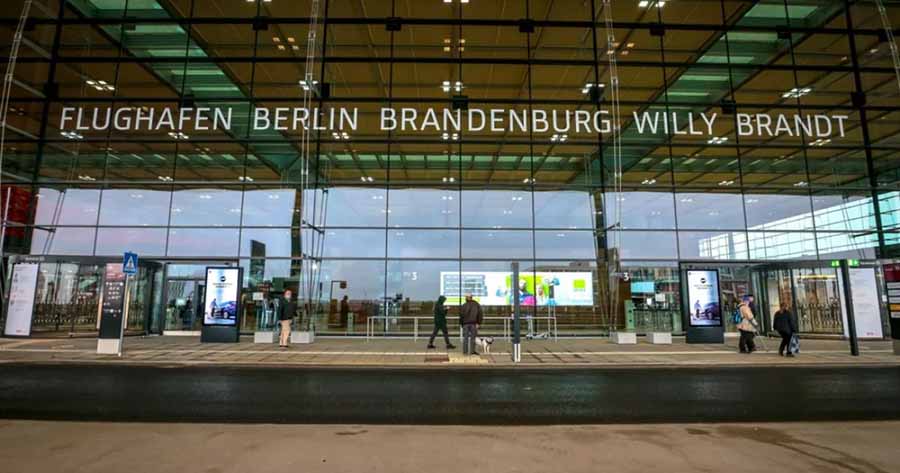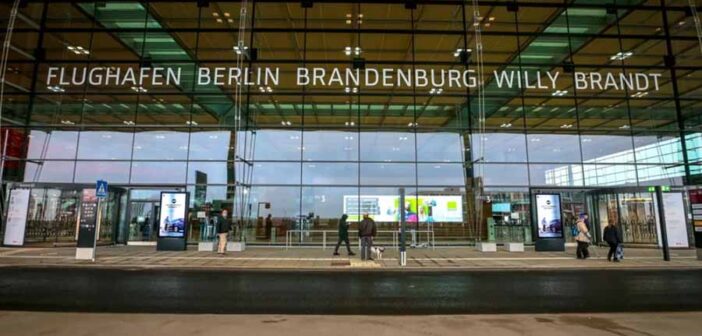
Berlin Brandenburg Airport (BER), known as Willy Brandt Airport, located 18 kilometres southeast of Berlin’s city centre in Schِnefeld, serves as Germany’s third-busiest airport, handling over 25.5 million passengers in 2024.
This modern hub, which replaced the older Tegel, Schِnefeld, and Tempelhof airports, offers a functional and efficient experience for travellers. The airport operates primarily through Terminals 1 and 2, with Terminal 5 (the former Schِnefeld Airport) permanently closed since February 2021.
Terminal 1, a U-shaped structure with seven levels, manages the majority of flights, while the smaller Terminal 2 caters to low-cost carriers like Ryanair and easyJet. The layout is clear, with check-in areas on level E1, security and gates on E2, and a central marketplace connecting departures. Signage in English and German aids navigation, though the size of Terminal 1 can mean longer walks to distant gates.
Access to the airport is seamless, with robust public transport links. The Airport Express (FEX) train connects Berlin Central Station to the airport’s underground railway station in about 30 minutes for €4.40, running every half hour. S-Bahn lines S9 and S45, as well as regional trains like RE8 and RB23, provide additional options, with journeys to the city centre taking 30-50 minutes. Express buses, such as X7 and X71, link to U-Rudow station in 18 minutes, offering connections to Berlin’s U-Bahn network.
Taxis from the official rank at Terminal 1 cost €60-€70 for a 35-45 minute ride to central Berlin, though traffic can extend this. Drivers benefit from direct access via the A113 motorway, with over 10,000 parking spaces, including short-term, long-term, and Kiss & Fly zones, bookable online. Car sharing services like Bolt Drive and SIXT are available, and a car rental centre in car park P2 offers options from Europcar, Avis, and Hertz.
Dining and retail options are plentiful, particularly in Terminal 1’s 9,000-square-metre marketplace. Travellers can enjoy local German fare at restaurants like Marché Mِvenpick, alongside international chains such as Starbucks and McDonald’s. Terminal 2 offers simpler choices, including cafes and snack bars suited to budget travellers. Retail includes duty-free shops, German brands like Ampelmann, and international boutiques such as Marc O’Polo. Facilities are comprehensive, with free Wi-Fi, currency exchange, and a hair salon in Terminal 1.
The Berlin Welcome Center in the arrivals area sells public transport tickets and provides tourist information. Four lounges, including the Lounge Tempelhof and BER Lounge, offer snacks, drinks, and Wi-Fi for €25-€35, with an observation deck for airfield views. Accessibility is strong, with barrier-free parking, lifts, and free mobility services for passengers with reduced mobility, though requests should be made 48 hours in advance. Napcabs sleeping pods in Terminal 1, priced at €34 per hour, provide a restful retreat, and luggage storage is available at the Service Centre.
On-time performance has improved since the airport’s opening in October 2020, but challenges persist. Congestion during peak hours can lead to security queues of up to 30 minutes, and baggage handling delays have been reported, sometimes exceeding two hours due to staff shortages. Weather disruptions and air traffic control issues also contribute to occasional delays. Travellers are advised to arrive three hours early for international flights to navigate potential bottlenecks.
Connections are efficient within Terminals 1 and 2, with a 400-metre walk between them taking about five minutes. The integrated layout eliminates the need for inter-terminal shuttles, and minimum connection times are around 45 minutes for most flights. Passengers with separate tickets may need to reclaim luggage and recheck, adding up to an hour.
Non-Schengen gates are located in the C and D piers of the main Terminal 1/2 complex, after passport control. These gates are specifically designated for flights departing to non-Schengen countries and are accessed via separate security areas, sometimes requiring a second screening for certain destinations like the USA.
Potential delays to watch for include lengthy check-in and security lines, particularly during morning and evening peaks. Inconsistent staff service and unclear signage have frustrated some travellers, while baggage handling inefficiencies can slow arrivals. The airport’s fire protection system, a historical source of delays, remains a point of vigilance, though recent upgrades have stabilised operations.
Aer Lingus
Aer Lingus operates from Terminal 1 at Berlin Brandenburg Airport for flights to Dublin. Check-in desks are typically in the Check-in Area A or B (desks A01–A20 or B01–B20), but exact assignments vary. Check-in opens 2 hours before departure and closes 45 minutes before departure. Online check-in is available up to 4.5 hours prior. Departures are usually from Gates D usually 1-5 in the non-Schengen area. Passengers should check real-time gate assignments on airport screens or the Aer Lingus app.
Ryanair
Ryanair operates daily flights to Dublin from Berlin from Terminal 2, with check-in desks typically in the main check-in area (desks 200–250). Passengers should check airport screens for exact assignments. Flights to Ireland (Dublin) depart from Terminal 2, usually gates in the B concourses (B40–V60, sometimes U10–U20 or V50–V60). Gates are assigned dynamically and displayed on departure boards.
- Note that Berlin Brandenburg is a modern airport, and gate assignments are typically announced close to departure time.




